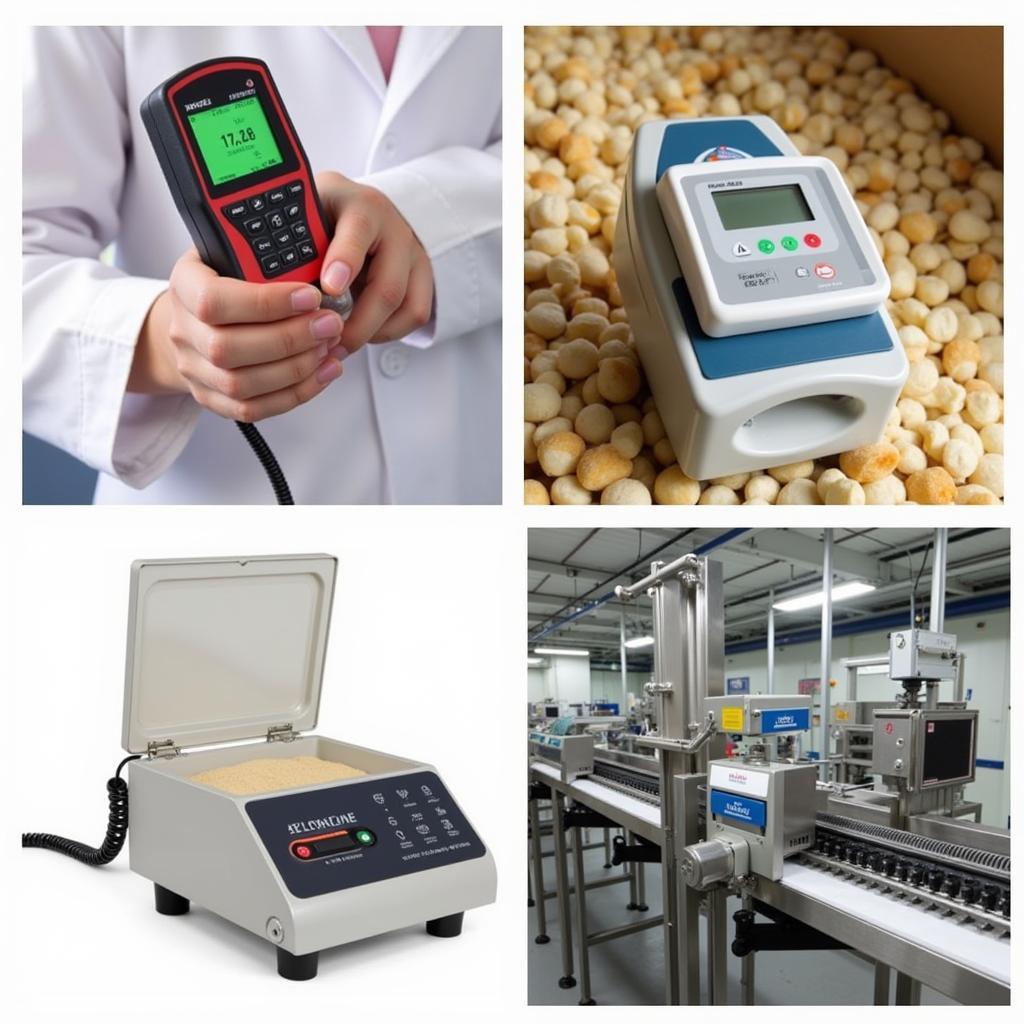The quality and safety of food products are paramount in the food industry. A key factor influencing these aspects is moisture content. This is where a Moisture Meter For Food Industry use becomes an indispensable tool. Accurately measuring moisture levels ensures product stability, prevents spoilage, and maintains overall quality control.
Why is Moisture Content So Important in the Food Industry?
Moisture plays a critical role in the texture, taste, and shelf life of food. It can also impact the growth of microorganisms, leading to spoilage and safety concerns. Controlling moisture levels is crucial for:
- Product Consistency: Achieving consistent moisture content guarantees uniform texture and taste across batches. Imagine biting into a cookie; you expect a certain crunch. A moisture meter helps ensure that crunch remains the same every time.
- Shelf Life Extension: Excess moisture can create an environment ripe for bacteria and mold growth, leading to spoilage. Precise moisture control significantly extends shelf life and minimizes waste.
- Meeting Regulatory Standards: Food safety regulations often stipulate acceptable moisture levels for different products. A reliable moisture meter ensures compliance and avoids potential legal issues.
- Optimizing Processing: Many food processing techniques, like drying or baking, require specific moisture levels for optimal results. A moisture meter helps fine-tune these processes for efficiency and quality.
Types of Moisture Meters for the Food Industry
Choosing the right moisture meter depends on the specific needs of your food production. Here are some common types:
1. Handheld Moisture Meters
These portable devices are ideal for quick, on-the-spot measurements. They are commonly used for checking moisture in grains, powders, and other dry ingredients.
2. Benchtop Moisture Meters
Offering greater accuracy and a wider range of features, benchtop meters are suitable for laboratory settings and high-volume testing. They are often used for analyzing moisture content in finished products.
3. In-Line Moisture Meters
For continuous monitoring during the production process, in-line meters are integrated directly into the production line. They provide real-time data and can automatically adjust processing parameters to maintain optimal moisture levels.
 Different Moisture Meters for Food Applications
Different Moisture Meters for Food Applications
How to Choose the Right Moisture Meter
With a variety of options available, selecting the right moisture meter involves considering several factors:
- Type of Food Product: Different foods have varying moisture ranges and textures. Choose a meter specifically calibrated for your product type.
- Required Accuracy: The level of accuracy needed depends on the product and application. For example, analyzing moisture in spices might require higher accuracy than measuring moisture in grains.
- Portability vs. Lab Use: Decide whether you need a portable device for quick checks or a stationary unit for more in-depth analysis.
- Budget and Features: Moisture meters come with various features like data logging, connectivity options, and different measurement ranges. Consider your budget and specific requirements.
Benefits of Using a Moisture Meter for Food Industry Applications
Investing in a high-quality moisture meter offers numerous advantages:
- Enhanced Product Quality: Consistent moisture levels translate to superior product quality, meeting consumer expectations for taste and texture.
- Reduced Spoilage and Waste: Accurate moisture control minimizes the risk of spoilage, leading to less waste and increased profitability.
- Improved Food Safety: Maintaining optimal moisture levels helps prevent the growth of harmful bacteria and molds, ensuring food safety.
- Increased Efficiency and Profitability: Moisture meters optimize processing times, reduce waste, and ensure consistent product quality, ultimately boosting efficiency and profitability.
Moisture Meters: An Investment in Quality and Safety
In the competitive food industry, maintaining the highest standards of quality and safety is non-negotiable. A moisture meter is not just a measuring instrument; it is a vital tool for achieving these standards. By providing accurate and reliable moisture readings, these devices empower food manufacturers to deliver safe, high-quality products while optimizing their processes and maximizing profitability.
FAQs
What is the typical moisture range for food products?
The ideal moisture range varies widely depending on the specific food. For instance, grains typically have a moisture range of 10-14%, while baked goods like bread can have a moisture content between 30-40%.
How often should I calibrate my moisture meter?
Regular calibration is crucial for accurate readings. The frequency depends on usage but, as a general guideline, calibrate your meter at least once a year or more frequently if used heavily.
Can I use the same moisture meter for different food products?
While some meters offer versatility, it’s recommended to use meters calibrated for the specific food type you’re measuring to ensure the highest level of accuracy.
What are some common signs of excessive moisture in food products?
Clumping, mold growth, an off smell, and a shorter shelf life are all indicators of high moisture content in food.
Are there any safety precautions when using a moisture meter?
Always follow the manufacturer’s instructions and wear appropriate safety gear when operating a moisture meter. Avoid using the meter near water or in excessively humid environments.
Need Help Finding the Perfect Moisture Meter?
Contact us at Phone Number: 02437655121, Email: [email protected] or visit our address: 3PGH+8R9, ĐT70A, thôn Trung, Bắc Từ Liêm, Hà Nội, Việt Nam. We have a dedicated customer support team available 24/7 to assist you. Explore our range of food safe adhesive for plastic, fried food warmer, and big food warmers for all your food industry needs.